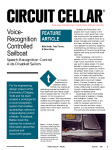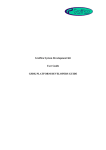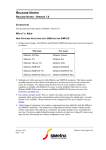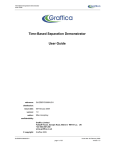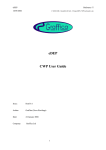Download TCAS 2004 User Guide - EUROCONTROL Experimental Centre
Transcript
TCAS 2004 Reference GL/<project>/<type>/<no> 21 June 2004 D:\Continuus\ccm_wa\ino\eDEP_Documentation- 2004A\eDEP_Documentation\guides\TCAS_UserGuide.doc TCAS 2004 User Guide Issue: Draft 0.6 Author: Graffica Date: 21 June 2004 Company: Graffica Ltd Page 1 of 18 TCAS 2004 Reference GL/<project>/<type>/<no> 21 June 2004 D:\Continuus\ccm_wa\ino\eDEP_Documentation- 2004A\eDEP_Documentation\guides\TCAS_UserGuide.doc Table Of Contents 1 Introduction .....................................................................................................................................3 Version History .......................................................................................................................3 1.2 References ...............................................................................................................................3 1.3 Abbreviations ..........................................................................................................................3 2 1.1 Installation Notes.............................................................................................................................4 2.1 Haptic Alarm ...........................................................................................................................4 2.2 Support For MP3 Files ............................................................................................................5 3 Resource Descriptions.....................................................................................................................6 4 Revised Resolution Advisory File Format ....................................................................................10 4.1 Examples ...............................................................................................................................10 5 Scenarios .......................................................................................................................................11 6 The Launcher.................................................................................................................................12 7 Sound Clips File ............................................................................................................................14 8 Launching The Air Configuration.................................................................................................15 9 Changing TCAS Alert Colours .....................................................................................................16 10 Stopping Scenarios At a Specified Time...................................................................................17 11 Using The ILS Capability..........................................................................................................18 Page 2 of 18 TCAS 2004 Reference GL/<project>/<type>/<no> 21 June 2004 D:\Continuus\ccm_wa\ino\eDEP_Documentation- 2004A\eDEP_Documentation\guides\TCAS_UserGuide.doc 1 INTRODUCTION The aim of this document is to assist eDEP users with the activities of platform installation, configuration and launching. This note contains information detailing: • the installation of the software necessary to drive the TCAS haptic alarm; • the set up of the TCAS resource parameters; and • the revised file format containing the resolution advisories used by TCAS. For more information concerning the platform design the reader should address either the Architecture Design Document (ADD) [Ref. 1] or the Detailed Design Document (DDD). 1.1 VERSION HISTORY Release Author Release Date Release Description 0.1 Graffica (Eveleigh) 10th 2003 Sept. Initial Created. 0.2 Graffica (Eveleigh) 16th 2003 Sept. Second release. Updated. 0.3 Graffica (Prokop) 27th Oct. 2003 Third release. Updated. 0.4 Graffica (Prokop) 3rd Nov. 2003 Updated following simulation. 0.5 Graffica (Aynsworth) 17th 2004 0.6 Graffica (Aynsworth) 21st June 2004 Sixth release. Fourth release. March Fifth release. Modifications (sections affected and relevant information) Updated for 2004 simulations. Added description of TCAS server resources. 1.2 REFERENCES The following documents are referenced. 1. eDEP Architecture Design Doc., GL/eDEP/ADD/1 V1.8, M. Vere, March 2003 2. eDEP GSDK Detailed Design, 1.5, M.Vere, October 2002 3. eDEP ATC Detailed Design, GL/eDEP/DDD/1/1.9, M. Vere, March 2003 4. eDEP User Guide, Graffica, May 2004. 5. eDEP ATCX User Guide, Graffica, May 2004. 1.3 ABBREVIATIONS Abbreviation Meaning CWP Controller Working Position IDE Integrated Development Environment JRE Java Runtime Environment JVM Java Virtual Machine SDK Software Development Kit Page 3 of 18 TCAS 2004 Reference GL/<project>/<type>/<no> 21 June 2004 D:\Continuus\ccm_wa\ino\eDEP_Documentation- 2004A\eDEP_Documentation\guides\TCAS_UserGuide.doc 2 INSTALLATION NOTES 2.1 HAPTIC ALARM To install the driver necessary to control the haptic alarm through a parallel port follow the installation instructions at www.geocities.com/juanga69/parport. This will involve copying parport.dll to your <JDK>\bin i.e. the bin folder below your JDK installation. If you have Windows NT (or higher) then you will also need to install UserPort. You will need administrator privileges to use UserPort as it grants you access to hardware addresses that are not usually available to a user. Step by step instructions for the installation of parport and UserPort can be obtained from www.geocities.com/juanga69/parport. If the parport.dll file is not copied to the correct location, a Java UnsatisifiedLinkError will be generated. If the UserPort software is not used to provide access to the parallel port addresses, an exception will be raised when eDEP attempts to control the port. Typical output when this exception is raised is shown below. An unexpected exception has been detected in native code outside the VM. Unexpected Signal : EXCEPTION_PRIV_INSTRUCTION occurred at PC=0xD30107B Function=[Unknown.] Library=C:\j2sdk1.4.0_01\bin\parport.dll NOTE: We are unable to locate the function name symbol for the error just occurred. Please refer to release documentation for possible reason and solutions. Current Java thread: at parport.ParallelPort.writeOneByte(Native Method) at parport.ParallelPort.write(ParallelPort.java:60) at test.parallel.SimpleHapticTest.sendHexPair(SimpleHapticTest.java:45) at test.parallel.SimpleHapticTest$ButtonListener.actionPerformed(SimpleHapticTest.java:84) at java.awt.Button.processActionEvent(Button.java:381) at java.awt.Button.processEvent(Button.java:350) at java.awt.Component.dispatchEventImpl(Component.java:3526) at java.awt.Component.dispatchEvent(Component.java:3367) at java.awt.EventQueue.dispatchEvent(EventQueue.java:445) at java.awt.EventDispatchThread.pumpOneEventForHierarchy(EventDispatchThread.java:191) at java.awt.EventDispatchThread.pumpEventsForHierarchy(EventDispatchThread.java:144) at java.awt.EventDispatchThread.pumpEvents(EventDispatchThread.java:138) at java.awt.EventDispatchThread.pumpEvents(EventDispatchThread.java:130) at java.awt.EventDispatchThread.run(EventDispatchThread.java:98) Dynamic libraries: 0x00400000 - 0x00406000 0x77F80000 - 0x77FFB000 0x0E800000 - 0x0E80B000 C:\j2sdk1.4.0_01\bin\javaw.exe C:\WINNT\System32\ntdll.dll C:\WINNT\System32\PSAPI.DLL Local Time = Tue Sep 09 17:40:44 2003 Elapsed Time = 4 # # The exception above was detected in native code outside the VM # # Java VM: Java HotSpot(TM) Client VM (1.4.0_01-b03 mixed mode) # Page 4 of 18 TCAS 2004 Reference GL/<project>/<type>/<no> 21 June 2004 D:\Continuus\ccm_wa\ino\eDEP_Documentation- 2004A\eDEP_Documentation\guides\TCAS_UserGuide.doc 2.2 SUPPORT FOR MP3 FILES If MP3 Support is required, the Java SPI is required. This library is platform independent. The Java SPI Framework is available for download from: http://www.javazoom.net/mp3spi/mp3spi.html Copy tritonus_share.jar, mp3spi1.9.jar and jl0.4.jar into the TOOLS directory and add a reference to each in eclipse in Project – Properties – Java Build Path – Libraries. Page 5 of 18 TCAS 2004 21 June 2004 3 Reference GL/<project>/<type>/<no> D:\Continuus\ccm_wa\ino\eDEP_Documentation-2004A\eDEP_Documentation\guides\TCAS_UserGuide.doc RESOURCE DESCRIPTIONS RESOURCE TYPICAL VALUE DESCRIPTION IFPL.SCENARIO "tcas/resources/scenarios/54/CORA1_54_TRAFFIC.dat" The traffic file used in the scenario. This resource is set automatically in the launcher. IAS.SCENARIO_READER "tcas.ias.server.TCASScenarioReaderImpl" The Scenario Reader class implementation defined for TCAS. TCAS.ABBREVIATE_CLEAR "COC" TCAS.ABBREVIATE_CLIMB "CLM" TCAS.ABBREVIATE_CLIMB_CLIMB "ICL" TCAS.ABBREVIATE_DESCEND "DES" TCAS default abbreviations/symbols. Note: can use Unicode to define symbols e.g. replace “CLM” with “\\u2191” to get up arrow. Similarly, replace “ICL” with \\u2191\\u2191 to get a double up arrow. TCAS.ABBREVIATE_DESCEND_DESCEND "IDE" TCAS.ABBREVIATE_CLIMB_500FPM “LC5” TCAS.ABBREVIATE_CLIMB_1000FPM “LC1” TCAS.ABBREVIATE_CLIMB_2000FPM “LC2” TCAS.ABBREVIATE_DESCEND_500FPM "LD5" TCAS.ABBREVIATE_DESCEND_1000FPM "LD1" TCAS.ABBREVIATE_DESCEND_2000FPM "LD2" TCAS.RESOLUTION_FLASH_RATE_MS 1000.0 Duration, which TCAS label and/or background will remain on when flashing. TCAS.RESOLUTION_FLASH_OFF_RATE_MS 1000.0 Duration, which TCAS label and/or background will remain off when flashing. VVC.AUDIO_ALARM.CLASS "tcas.vvc.server.AudioAlarmImpl" The Audio alarm class implementation defined for TCAS. VVC.STCA_WARNING ON Can be either ON or OFF. When ON STCA “softly spoken” warning will be issued. VVC.STCA_STERN_WARNING ON Can be either ON or OFF. When ON STCA Page 6 of 18 TCAS 2004 21 June 2004 Reference GL/<project>/<type>/<no> D:\Continuus\ccm_wa\ino\eDEP_Documentation-2004A\eDEP_Documentation\guides\TCAS_UserGuide.doc RESOURCE TYPICAL VALUE DESCRIPTION “sternly spoken” (2nd) warning will be issued. VVC.HAPTIC_ALARM.CLASS "tcas.vvc.server.HapticAlarmImpl" The Haptic alarm class implementation defined for TCAS. VVC.PARALLEL_PORT_ADDRESS 888 Parallel port address (decimal) of haptic alarm (888 = 0x378). VVC.HAPTIC_ALARM_SIGNAL_ON 128 Byte value (decimal) to switch alarm on (128 = 0x80). VVC.HAPTIC_ALARM_SIGNAL_OF 0 Byte value (decimal) to switch alarm off. VVC.RESOLUTION_TCAS_AUDIO_PERIOD_MS 5000.0 Time (ms) at which TCAS audio alarm will be repeated. VVC.RESOLUTION_VIBRATE_DURATION_MS 10000.0 Duration (ms) which haptic alarm will vibrate for. VVC.SCENARIO "tcas/resources/scenarios/54/54_sounds.dat The location of the sound clips file. This resource is set automatically in the launcher. The name is derived from the scenario name. VVC.SOUNDFILE_DIRECTORY "tcas/resources/sounds/" The location of the sound clips played when an STCA or TCAS alert occurs. VVC.CONFLICT_CLIP conflict.wav 1st STCA clip to be played. The filename is specified relative to the sound file directory specified above. VVC.CONFLICT_CONFLICT_CLIP conflictconflict.wav 2nd STCA clip to be played. The filename is specified relative to the sound file directory specified above. Page 7 of 18 TCAS 2004 Reference GL/<project>/<type>/<no> 21 June 2004 D:\Continuus\ccm_wa\ino\eDEP_Documentation-2004A\eDEP_Documentation\guides\TCAS_UserGuide.doc RESOURCE TYPICAL VALUE DESCRIPTION VVC.TCAS_TCAS_CLIP tcastcas.wav TCAS alert to be played. The filename is specified relative to the sound file directory specified above. The TCAS Launcher uses the resources defined below to realize the four different HMI variants. TCAS.RESOLUTION_TEXT <string> The text to be displayed in the aircraft label, typically TCAS or RA. TCAS.RESOLUTION_DIRECTION <boolean> Determines whether the resolution sense is displayed. TCAS.RESOLUTION_FLASH_TEXT <boolean> Determines whether flashing text is displayed. TCAS.RESOLUTION_AC_INVOLVED <boolean> TCAS.RESOLUTION_BACKGROUND <”OFF” | “HIGHLIGHT” | “FLASH”> VVC.RESOLUTION_AUDIO <"OFF" | “SINGLE” | “CONTINUOUS”> Determines whether the TCAS warning is played and if it is played, whether it is played once or continuously. VVC.RESOLUTION_VIBRATE <"OFF" | “SINGLE” | “CONTINUOUS”> Determines whether the haptic alarm is triggered and if it is triggered, whether it is triggered once or continuously. TCAS.RESOLUTION_HIGHLIGHT_AC_INVOLVED <boolean> Determines whether an aircraft, involved in an advisory, without an advisory is highlighted. The settings for each of the four HMI variants are listed below. Changing these settings will enable the user to change the configuration of one of the predefined HMIs. TCAS.HMIMIN_RES_TEXT "TCAS" TCAS.HMIMIN_RES_DIRECTION FALSE TCAS.HMIMIN_RES_FLASH_TEXT FALSE TCAS.HMIMIN_RES_AC_INVOLVED FALSE TCAS.HMIMIN_RES_BACKGROUND HIGHLIGHT TCAS.HMIMIN_RES_AUDIO "OFF" Page 8 of 18 TCAS HMI Minimum configuration TCAS 2004 Reference GL/<project>/<type>/<no> 21 June 2004 D:\Continuus\ccm_wa\ino\eDEP_Documentation-2004A\eDEP_Documentation\guides\TCAS_UserGuide.doc RESOURCE TYPICAL VALUE TCAS.HMIMIN_RES_VIBRATE "OFF" TCAS.HMIMIN_RES_HIGHLIGHT_AC_INVOLVED TRUE TCAS.HMIINT_RES_TEXT "TCAS" TCAS.HMIINT_RES_DIRECTION TRUE TCAS.HMIINT_RES_FLASH_TEXT FALSE TCAS.HMIINT_RES_AC_INVOLVED FALSE TCAS.HMIINT_RES_BACKGROUND HIGHLIGHT TCAS.HMIINT_RES_AUDIO "OFF" TCAS.HMIINT_RES_VIBRATE "OFF" TCAS.HMIINT_RES_HIGHLIGHT_AC_INVOLVED TRUE TCAS.HMIEXT_RES_TEXT "TCAS" TCAS.HMIEXT_RES_DIRECTION TRUE TCAS.HMIEXT_RES_FLASH_TEXT FALSE TCAS.HMIEXT_RES_AC_INVOLVED FALSE TCAS.HMIEXT_RES_BACKGROUND FLASH TCAS.HMIEXT_RES_AUDIO "SINGLE" TCAS.HMIEXT_RES_VIBRATE "SINGLE" TCAS.HMIEXT_RES_HIGHLIGHT_AC_INVOLVED TRUE CLOCK.STOPTIME "16:43:00” ACSG.ACS_HOSTNAME The hostname of the ACAS Server ACSG.ACS_PORT The port on which to connect to the ACAS Server ACSG.LOCAL_PORT The port on the local machine to which to listen Page 9 of 18 DESCRIPTION TCAS HMI Intermediate configuration TCAS HMI Extreme configuration This determines the end time of the simulation. When set, the entire application shuts down at the specified time. TCAS 2004 Reference GL/<project>/<type>/<no> 21 June 2004 D:\Continuus\ccm_wa\ino\eDEP_Documentation- 2004A\eDEP_Documentation\guides\TCAS_UserGuide.doc 4 REVISED RESOLUTION ADVISORY FILE FORMAT TCAS_Advisory = <time> + <callsign> + <altitude> + [<advisory> + [<involved_aircraft>]]; Where time = nn:nn:nn callsign = name altitude = number involved_aircraft = name advisory = < “CLEAR” | <descend_advisory> | <climb_advisory> > descend_advisory = string starting with the text “DESCEND” climb_advisory = string starting with the text “CLIMB” 4.1 EXAMPLES Time Callsign Altitude Advisory Involved Aircraft 16:13:26 CNF001 31550 DESCEND SPOOF 16:13:27 CNF001 31550 DESCEND_DESCEND SPOOF 16:13:28 CNF001 31550 DESCEND_500FPM SPOOF 16:13:29 CNF001 31550 DESCEND_1000FPM SPOOF 16:13:29 CNF001 31550 DESCEND_QUICKLY SPOOF The advisories CLEAR, CLIMB and DESCEND have default abbreviations COC, CLM and DES but can be replaced by the user by defining abbreviations in the TCAS resource file. For any other advisory to be indicated on the display a matching abbreviation must exist in the TCAS resource file e.g. TCAS.ABBREVIATE_DESCEND_QUICKLY “DQ” Note: For backwards compatibility the previous advisories “DESCEND DESCEND” and “CLIMB CLIMB” can still be used but internally they will be treated as “DESCEND_DESCEND” and “CLIMB_CLIMB” respectively. Page 10 of 18 TCAS 2004 Reference GL/<project>/<type>/<no> 21 June 2004 D:\Continuus\ccm_wa\ino\eDEP_Documentation- 2004A\eDEP_Documentation\guides\TCAS_UserGuide.doc 5 SCENARIOS The CORA2 2002 traffic files have been added to the tcas scenarios. A distributed scenario has been created, this is TCASTest4. This scenario cannot be launched through the launcher. Bat files have been provided to launch this scenario. The common_distribution.gsdk file will need to be modified, to include the appropriate discovery host name. The original scenario files are compatible with the new file format. Page 11 of 18 TCAS 2004 Reference GL/<project>/<type>/<no> 21 June 2004 D:\Continuus\ccm_wa\ino\eDEP_Documentation- 2004A\eDEP_Documentation\guides\TCAS_UserGuide.doc 6 THE LAUNCHER The Launcher allows a TCAS scenario to be launched in a number of different distribution modes. The modes are 1. Standalone, where the scenario is run on a single machine 2. CWP Only, runs the CWP without the VVC 3. VVC Only, is run on a remote machine to pair with a CWP. Note: When running CWP Only on one machine and VVC Only on a remote machine care should be taken to make sure the same scenario is chosen and the HMI variants chosen correspond to what is desired. Note: configuring sound options on the CWP Only machine will have no effect on the VVC and vice versa. The TCAS launcher provides a number of differing HMI variants. The launcher, showing the available HMI variants, is shown in Figure 1, below. Figure 1 Launcher Showing HMI Variants It can be seen from Figure 1 that the launcher supports a customise HMI mode This allows a user to create a bespoke HMI. If the user selects the customise HMI variant, a second tabbed pane, named RAOptions, is included in the launcher. This is shown in figure 2, below. Page 12 of 18 TCAS 2004 Reference GL/<project>/<type>/<no> 21 June 2004 D:\Continuus\ccm_wa\ino\eDEP_Documentation- 2004A\eDEP_Documentation\guides\TCAS_UserGuide.doc Figure 2 Launcher with RAOptions Tab Figure 3, below, illustrates the options that can be customised through the launcher. Figure 3 Defining a Customised HMI Customised HMIs cannot be saved. However, the contents of the standard HMIs can be changed through the resource parameters. Page 13 of 18 TCAS 2004 Reference GL/<project>/<type>/<no> 21 June 2004 D:\Continuus\ccm_wa\ino\eDEP_Documentation- 2004A\eDEP_Documentation\guides\TCAS_UserGuide.doc 7 SOUND CLIPS FILE An example scenario sound clips file is shown above. When adding sound clips, the following rules shall be followed: //time filename // 16:12:10 "AF855PT 16:12:11 "AF855PT 16:19:10 "AF936EZ 16:19:30 "AF936EZ leaves_with acnoise.wav" leaves_with acnoise.wav" Leave_with_hum+noise.mp3" Leave_with hum+noise.wav" The sound clips, i.e. the .wav or mp3 files, shall reside in a directory, sounds, located in the scenario directory. For example, given the scenario TCASTest1, the sound clips are located in TCASTest1/sounds. The file name of the scenario sound clips file shall be <<scenario_name>>_sounds.dat, e.g. for the test scenario TCASTest1, the scenario sound clips file is TCASTest1_sounds.dat. This file shall be located in the scenario directory; in the example TCASTest1. The resource VVC.SCENARIO specifies the location of the sound clips file. This resource is set automatically in the launcher. It is not necessary to set this resource in the scenario’s resource file. The location is derived from the scenario name. Given the scenario TCASTest1, located in the directory TCASTest1, the resource would be set to: "tcas/resources/scenarios/TCASTest1/TCASTest1_sounds.dat" If the Java SPI is installed as described in the installation notes, MP3 files can be used in addition to WAV files. The type of file is determined by the file extension. Page 14 of 18 TCAS 2004 Reference GL/<project>/<type>/<no> 21 June 2004 D:\Continuus\ccm_wa\ino\eDEP_Documentation- 2004A\eDEP_Documentation\guides\TCAS_UserGuide.doc 8 LAUNCHING THE AIR CONFIGURATION The air configuration is automatically launched if the resource parameter IAS.TRAJECTORY_TO_FLY is set to AIRCRAFT in the tcas_cwp.gsdk file. In addition to specifying flown trajectory, it is also necessary to list the Pilot Working Positions to be included in the scenario. This is achieved by setting the PWP.NAMES resource parameter. The PWPs are assigned to sectors in the tcas_pwp.gsdk file, an extract of this file is shown in the figure below. @LOAD "atcapp/resources/common/pwp_defaults.gsdk" PWP1.FREQUENCY ( 124.3, 126.7, 133.35, 135.45 ) PWP2.FREQUENCY (120.185, 122.725, 119.25, 120.15, 119.15 ) PWP1.WIDTH 900 PWP1.HEIGHT 800 PWP1.PVD.WIDTH 300 PWP1.PVD.HEIGHT 300 PWP1.PVD.LATITUDE 50.0 PWP1.PVD.LONGITUDE 3.0 PWP1.PVD.SCALE 200 An option to launch the air configuration is not included in the Launcher because it was thought that this would be an option that would not change on a regular basis, and it could even lead to some confusion. Page 15 of 18 TCAS 2004 Reference GL/<project>/<type>/<no> 21 June 2004 D:\Continuus\ccm_wa\ino\eDEP_Documentation- 2004A\eDEP_Documentation\guides\TCAS_UserGuide.doc 9 CHANGING TCAS ALERT COLOURS The colours of the TCAS alert buttons are configured, and hence may be changed, through the TCAS logical colour file. This file is located in tcas/resources. The contents of this file are illustrated below. The physical colours referenced in this file, in the example below, Orange and Green, must be included in the eDEP physical colours file. This file is located in atcapp/resources/common/graphics. TCAS.LOGICAL_COLOURS ( ( ALERT_DEFAULT_BACKGROUND, Orange ), ( ALERT_DEFAULT_FOREGROUND, Green ) ) Page 16 of 18 TCAS 2004 Reference GL/<project>/<type>/<no> 21 June 2004 D:\Continuus\ccm_wa\ino\eDEP_Documentation- 2004A\eDEP_Documentation\guides\TCAS_UserGuide.doc 10 STOPPING SCENARIOS AT A SPECIFIED TIME There are two mechanisms for stopping a scenario: specifying the CLOCK.STOPTIME resource parameter or using the scripted event tool. The resource parameter mechanism is detailed in the eDEP User Guide [Ref. 5] whilst the scripted event mechanism is described in the eDEP ATC Extensions User Guide [Ref. 5]. Page 17 of 18 TCAS 2004 Reference GL/<project>/<type>/<no> 21 June 2004 D:\Continuus\ccm_wa\ino\eDEP_Documentation- 2004A\eDEP_Documentation\guides\TCAS_UserGuide.doc 11 USING THE ILS CAPABILITY If the ILS landing functionality is to be utilised, the ils_defaults.gsdk resource file must be loaded. It is imperative that a STAR’s constituent points correctly align the aircraft with the runway; otherwise the aircraft will not be captured by the ILS. There is a thirty degree capture angle in which the approach the runway. final STAR point runway Aircraft must enter through this box within +- 30 degrees of the centre line. Figure 4 ILS Capability Page 18 of 18 final STAR point





















